2017初中英语八种时态归纳表格
- 格式:doc
- 大小:72.00 KB
- 文档页数:3


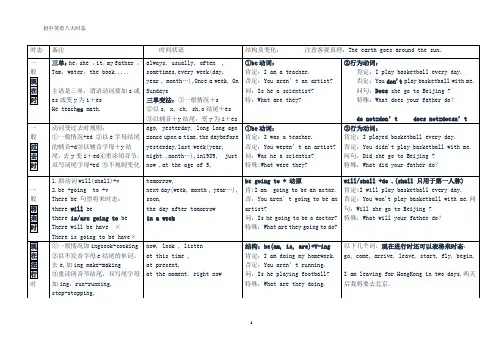
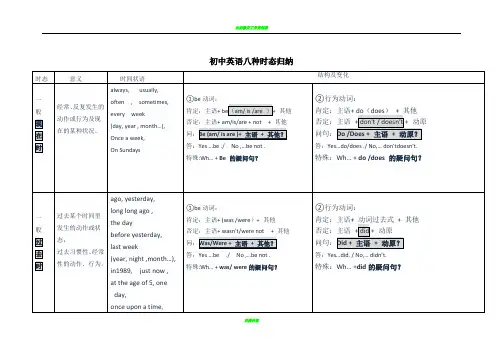

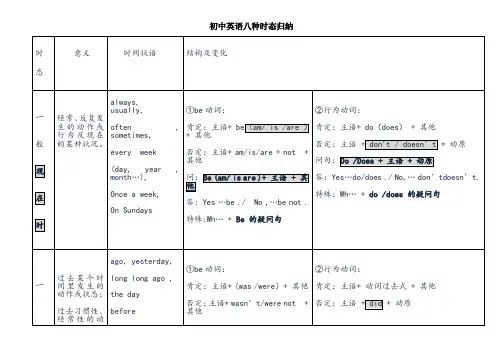

初中时态语态总结表格初中时态语态总结表格动词形式一般现在时一般过去时一般将来时完成时态进行时态被动语态一般形式 V原形+s/es V-ed will/shall+V原形have/has+V过去分词 am/is/are+V-ing am/is/are+V过去分词例句 She plays basketball. He studied English yesterday. I will go to the beach tomorrow. They have finished their homework. I am watching TV now. The book was written by Mark.时态解释表示现在发生的动作或状态。
表示过去发生的动作或状态。
表示将来发生的动作或状态。
表示过去发生并一直延续到现在的动作或状态。
表示说话时正在进行的动作或状态。
表示动作的承受者。
一般性使用主语+动词主语+动词ed 主语+will/shall+动词主语+have/has+动词ed 主语+am/is/are+动词ing 主语+am/is/are+动词过去分词一般疑问句助动词(do/does)/be动词(is/am/are)+主语+动词助动词(did)/be动词(was/were)+主语+动词助动词(will/shall)/be动词(is/am/are)+主语+动词助动词(have/has)/be动词(is/am/are)+主语+动词ed 助动词(am/is/are)/be动词(is/am/are)+主语+ 动词ing 助动词(am/is/are)/be动词(is/am/are)+主语+动词过去分词特殊疑问句疑问词+助动词(do/does)/be动词(is/am/are)+主语+动词疑问词+助动词(did)/be动词(was/were)+主语+动词疑问词+助动词(will/shall)/be 动词(is/am/are)+主语+动词疑问词+助动词(have/has)/be动词(is/am/are)+主语+动词ed 疑问词+助动词(am/is/are)/be动词(is/am/are)+主语+ 动词ing 疑问词+助动词(am/is/are)/be动词(is/am/are)+主语+动词过去分词否定句主语+助动词(do not/does not)/be动词(is/am/are not)+动词主语+助动词(did not)/be动词(was/were not)+动词主语+助动词(will/shall not)/be动词(is/am/are not)+动词主语+助动词(have/has not)/be 动词(is/am/are not)+动词ed 主语+助动词(am not/is not/are not)/be动词(is/am/are not)+动词ing 主语+助动词(am not/is not/are not)/be动词(is/am/are not)+动词过去分词情态动词主语+情态动词+动词原形主语+情态动词+动词原形主语+will/shall+情态动词+动词原形主语+have/has+情态动词+动词原形主语+am/is/are+情态动词+ 动词ing 主语+am/is/are+情态动词+动词过去分词现在进行时主语+am/is/are+V-ing 主语+was/were+V-ing 主语+will/shall+be+V-ing 主语+have/has+been+V-ing - -过去进行时主语+was/were+V-ing -- - - -将来进行时主语+will/shall+be+V-ing -- - - -完成进行时主语+have/has+been+V-ing 主语+had+been+V-ing - -- -被动语态主语+am/is/are+V过去分词主语+was/were+V过去分词主语+will/shall+be+V过去分词主语+have/has+been+V过去分词主语+am/is/are+being+V过去分词主语+am/is/are+V过去分词。
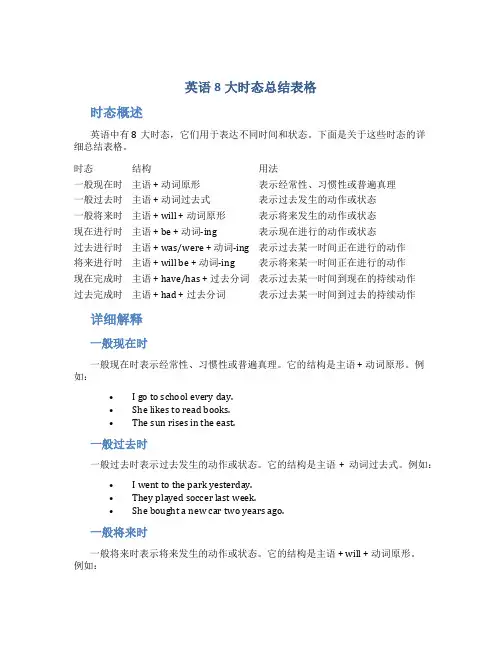
英语8大时态总结表格时态概述英语中有8大时态,它们用于表达不同时间和状态。
下面是关于这些时态的详细总结表格。
时态结构用法一般现在时主语 + 动词原形表示经常性、习惯性或普遍真理一般过去时主语 + 动词过去式表示过去发生的动作或状态一般将来时主语 + will + 动词原形表示将来发生的动作或状态现在进行时主语 + be + 动词-ing 表示现在进行的动作或状态过去进行时主语 + was/were + 动词-ing 表示过去某一时间正在进行的动作将来进行时主语 + will be + 动词-ing 表示将来某一时间正在进行的动作现在完成时主语 + have/has + 过去分词表示过去某一时间到现在的持续动作过去完成时主语 + had + 过去分词表示过去某一时间到过去的持续动作详细解释一般现在时一般现在时表示经常性、习惯性或普遍真理。
它的结构是主语 + 动词原形。
例如:•I go to school every day.•She likes to read books.•The sun rises in the east.一般过去时一般过去时表示过去发生的动作或状态。
它的结构是主语+ 动词过去式。
例如:•I went to the park yesterday.•They played soccer last week.•She bought a new car two years ago.一般将来时一般将来时表示将来发生的动作或状态。
它的结构是主语 + will + 动词原形。
例如:•I will travel to Japan next month.•They will have a party tomorrow.•She will call you later.现在进行时现在进行时表示现在正在进行的动作或状态。
它的结构是主语+ be + 动词-ing。
例如:•I am studying for the exam.•She is watching TV right now.•They are playing basketball in the park.过去进行时过去进行时表示过去某一时间正在进行的动作。
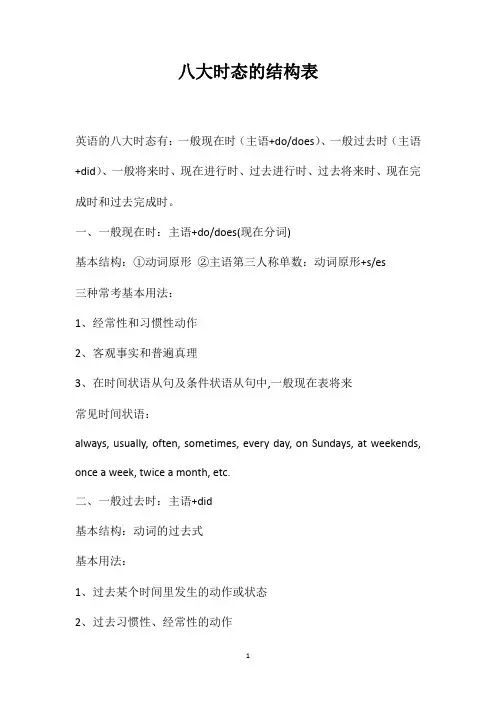
八大时态的结构表英语的八大时态有:一般现在时(主语+do/does)、一般过去时(主语+did)、一般将来时、现在进行时、过去进行时、过去将来时、现在完成时和过去完成时。
一、一般现在时:主语+do/does(现在分词)基本结构:①动词原形②主语第三人称单数:动词原形+s/es三种常考基本用法:1、经常性和习惯性动作2、客观事实和普遍真理3、在时间状语从句及条件状语从句中,一般现在表将来常见时间状语:always, usually, often, sometimes, every day, on Sundays, at weekends, once a week, twice a month, etc.二、一般过去时:主语+did基本结构:动词的过去式基本用法:1、过去某个时间里发生的动作或状态2、过去习惯性、经常性的动作常见时间状语:ago, yesterday, the day before yesterday, last week (year, night, month), in 1986, just now, at the age of 10, at that time, once upona time, etc.三、一般将来时:will do/基本结构:①am/is/are/going to + do;②will/shall + do.基本用法:1、(人)计划打算做某事2、(事)即将发生will/shall do1、将来的动作和状态(相对较长远)2、礼貌询问、客气邀请3、意愿常见时间状语:tomorrow, next day (week, month, year), soon, the day after tomorrow, in+时间段(格外注意),etc.四、现在进行时:主语+am/is/are doing基本结构:am/is/are+现在分词基本用法:1、此时此刻正在进行的动作2、现阶段正在进行的动作常见时间状语:now, at this time, these days, etc.五、过去进行时:was/were doing基本结构:was/were+现在分词基本用法:1、过去某时刻正在进行的动作2、过去某时段正在进行的动作常见时间状语:at this time yesterday, at that time或以when引导的谓语动词是一般过去时的时间状语等.六、过去将来时:was/were to /would do基本结构:①was/were/going to + do;②would/should + do.基本用法:从过去时间点看将来,常用于宾语从句中.常见时间状语:the next day (morning, year), the following month (week), etc.七、现在完成时:have/has done基本结构:have/has + 过去分词基本用法:1、过去发生的动作对现在造成的影响或结果2、过去已经开始,持续到现在的动作或状态常见时间状语:recently, lately, so far, up to now, since+时间点,for+时间段, in the past few years, etc.八、过去完成时:had done基本结构:had + 过去分词基本用法:以过去某个时间为标准,在此以前发生的动作或行为,即过去的过去.常见时间状语:before, after, by the end of last year(month),etc.。
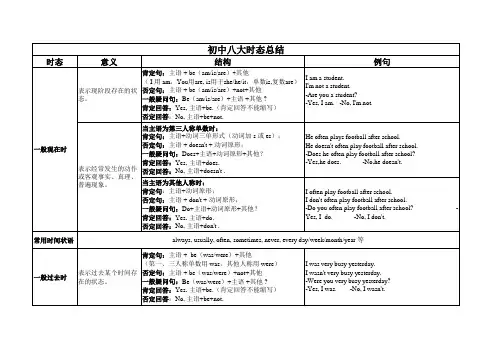
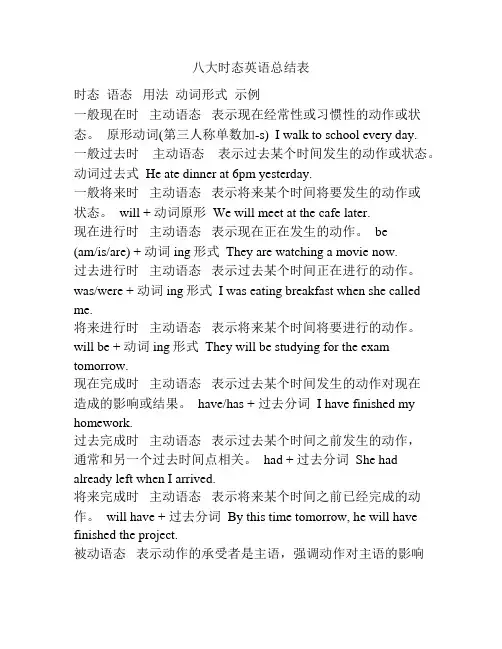
八大时态英语总结表时态语态用法动词形式示例一般现在时主动语态表示现在经常性或习惯性的动作或状态。
原形动词(第三人称单数加-s) I walk to school every day.一般过去时主动语态表示过去某个时间发生的动作或状态。
动词过去式 He ate dinner at 6pm yesterday.一般将来时主动语态表示将来某个时间将要发生的动作或状态。
will + 动词原形 We will meet at the cafe later.现在进行时主动语态表示现在正在发生的动作。
be(am/is/are) + 动词ing形式 They are watching a movie now.过去进行时主动语态表示过去某个时间正在进行的动作。
was/were + 动词ing形式 I was eating breakfast when she called me.将来进行时主动语态表示将来某个时间将要进行的动作。
will be + 动词ing形式 They will be studying for the exam tomorrow.现在完成时主动语态表示过去某个时间发生的动作对现在造成的影响或结果。
have/has + 过去分词 I have finished my homework.过去完成时主动语态表示过去某个时间之前发生的动作,通常和另一个过去时间点相关。
had + 过去分词 She had already left when I arrived.将来完成时主动语态表示将来某个时间之前已经完成的动作。
will have + 过去分词 By this time tomorrow, he will have finished the project.被动语态表示动作的承受者是主语,强调动作对主语的影响或结果。
be (am/is/are/was/were) + 过去分词 The book is being read by many people.。
展宏学校中考英语常考八大时态与被动语态类别一般现在时现在进行时现在完成时一般将来时用途谓语结构(动词形式 ) 被动结构时态标志1.表示经常性、习惯性的动作;表示现在(说话瞬间)正2.表示客观事实或永恒真理;在进行或发生的动作。
3.表示特征、爱好、状态和能力等。
V.原或 V.三单 (he/she/it 或能够用he/she/it 代替的人或物后用三单 )am / is / are + 过分am / is / are +being+过分1. 频率副词: often;sometimes=(at 1. now = at present = righttimes); always; usually; every day now = at the moment(every + 时间 ) 2. look, listen开头的句2. 次数: twice a week子。
3. on Sundays:在每一个星期天例句 :例句 :She is watering the treesHe often cleans the room. 主(动 )now. (主动 )The roomoften by him.The trees by(被动 )her now. (被动 )1. 表示发生在过去的动表示将来某个时间要发生的作一直持续到现在; 2.动作或存在的状态。
表示发生在过去的动作对现在造成的影响或结果。
have/has + 过分 1.will + V .原2.be going to + V.原have / has been + 过分will be + 过分1. for / since+时间; 1.将来的时间: tomorrow;the day2. 副词 ever, never, yet,after tomorrow;next week ;in a fewalready 等;days;in 3 years;in the future ;this3. so far = by now=up to evening/year/weeknow; 2. at once=in a minute=right away3.soon4.in the last/past few 例句 :years;She will do it tomorrow. ( 主动 )It by her5.over the years= in tomorrow. (被动 )recent years在主从复合句中,当主句为一般将来It ’s 7 o’clock + 现在进行时、主句为祈使句、主句含有情态动时。
以下是初中英语语法八大时态总结表格:时态用法构成时间状语一般现在时表示经常发生的动作或存在的状态主语+动词原形/第三人称单数形式+其他always, usually, often,sometimes, everyday/week/month/year, etc.一般过去时表示过去发生的动作或存在的状态主语+动词过去式+其他yesterday, lastweek/month/year, etc.现在进行时表示现在正在进行的动作主语+am/is/are+现在分词+其他now, at the moment, etc.过去进行时表示过去某个时刻正在进行的动作主语+was/were+现在分词+其他at this time yesterday,etc.一般将来时表示将要发生的动作或存在的状态主语+will/shall+动词原形+其他tomorrow, nextweek/month/year, etc.过去将来时表示过去将要发生的动作或存在的状态主语+would/should+动词原形+其他the next day, etc.时态用法构成时间状语现在完成时表示过去发生的动作对现在造成的影响或结果主语+have/has+过去分词+其他already, yet, ever, never,for/since, etc.过去完成时表示过去某个时间之前已经完成的动作主语+had+过去分词+其他by the time, before, etc.需要注意的是,这些时态的构成和用法可能会有一些例外情况,具体取决于语境和句子结构。
此外,不同的教材和地区可能会有一些差异,因此在学习过程中,建议你参考多种资料,以便更好地理解和掌握这些时态。
仁德外中考复篇初中英语八种时态归纳意状构及化一般常、反复生的作或行及在的某种状况。
在always,usually,often ,sometimes,every week(day,year,month⋯),Onceaweek,OnSundays①be:肯定:主+be〔am/is/are 〕+其他否认:主+am/is/are+not+ 其他:Be(am/isare)+ 主+其他?答:Yes⋯be./No, ⋯benot.特殊:Wh⋯+Be的疑句?②行:肯定:主+do〔does〕+其他否认:主+don't/doesn ’t+原句:Do/Does+ 主+原?答:Yes⋯do/does./No, ⋯don’tdoesn’t.特殊:Wh⋯+do/does 的疑句?一去某个里生的作或状般;去性、常去性的作、行。
一般表示将要生的将作或存在的状及打算、划或来准做某事。
ago,yesterday,longlongago,①be:theday肯定:主+(was/were〕+其他beforeyesterday,否认:主+wasn’t/werenot+其他lastweek:Was/Were+主+其他?(year,night,month⋯),答:Yes⋯be./No,⋯benot.in1989,justnow,特殊:Wh⋯+was/were的疑句?attheageof5,oneday,1 / 612 / 62onceuponatime,tomorrow,by ⋯, 根本构nextdaybegoingto+原(week,month,year⋯),;肯定:主+am/is/are/goingto+do soon,inafewminutes, 否:主+am/is/are+notgoingtodothedayaftertomorrow:Be+主+goingtodo ⋯⋯?答:Yes ⋯be./No, ⋯benot特殊:Wh ⋯+Be 主going todo 的疑句?②行:肯定:主+去式+其他否认:主+did+原句:Did+主+原? 答:Yes ⋯did./No, ⋯didn’t. 特殊:Wh ⋯+did 的疑句?will/shall+do. 肯定:主+will/shall+ 原形 否认:主+willnot 〔won’t〕+ 原形 句:Will/Shall 主+原形 ? 答句:Yes ⋯will./No, ⋯won’t. 特殊:Wh ⋯+will 的疑句?1仁德外中考复篇在表示段或行正在行的作及行。